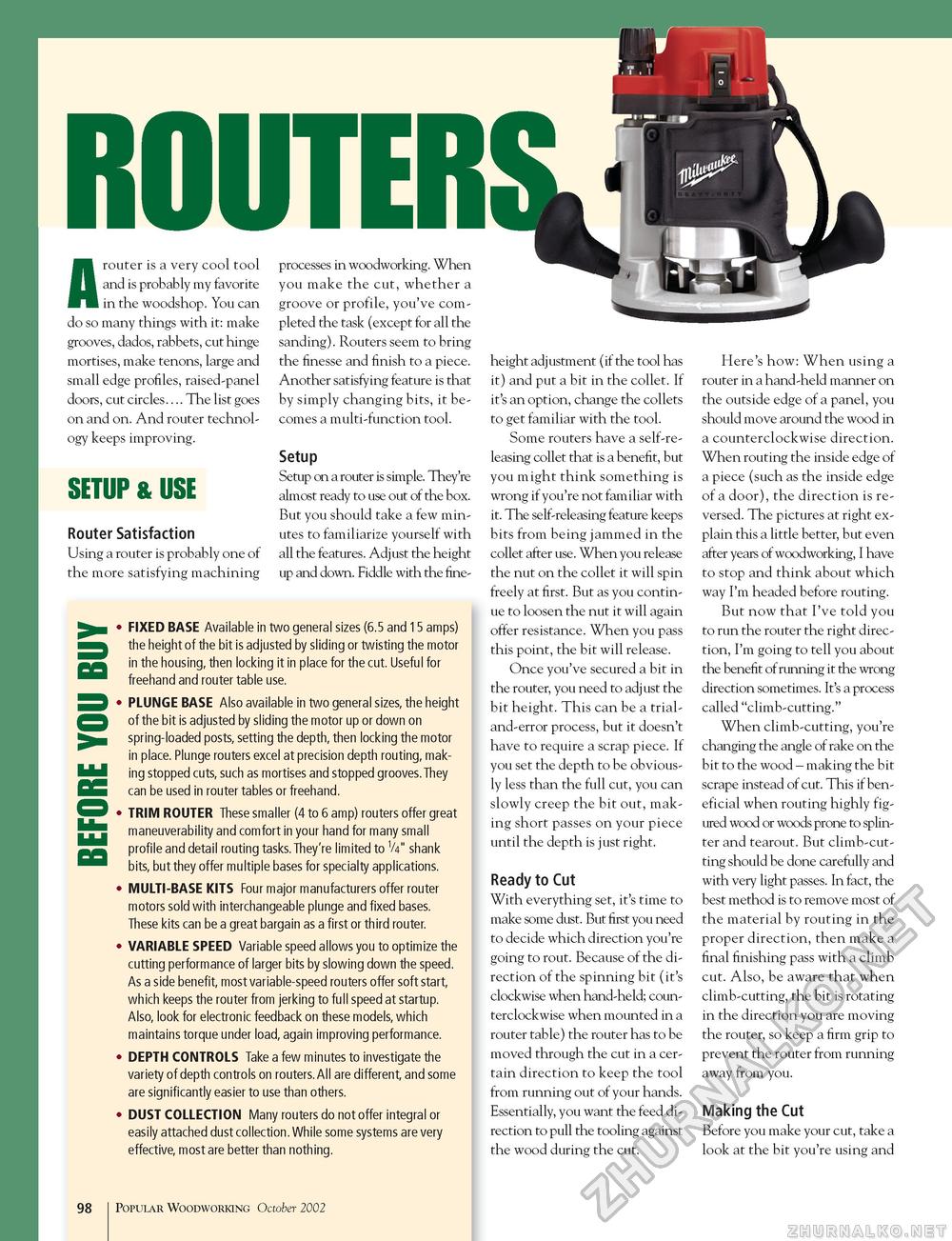Popular Woodworking 2002-10 № 130, страница 94
ROUTER* A router is a very cool tool and is probably my favorite in the woodshop. You can do so many things with it: make grooves, dados, rabbets, cut hinge mortises, make tenons, large and small edge profiles, raised-panel doors, cut circles____The list goes on and on. And router technology keeps improving. SETUP & USE Router Satisfaction Using a router is probably one of the more satisfying machining processes in woodworking. When you make the cut, whether a groove or profile, you've completed the task (except for all the sanding). Routers seem to bring the finesse and finish to a piece. Another satisfying feature is that by simply changing bits, it becomes a multi-function tool. Setup Setup on a router is simple. They're almost ready to use out of the box. But you should take a few minutes to familiarize yourself with all the features. Adjust the height up and down. Fiddle with the fine- FIXED BASE Available in two general sizes (6.5 and 15 amps) the height of the bit is adjusted by sliding or twisting the motor in the housing, then locking it in place for the cut. Useful for freehand and router table use. PLUNGE BASE Also available in two general sizes, the height of the bit is adjusted by sliding the motor up or down on spring-loaded posts, setting the depth, then locking the motor in place. Plunge routers excel at precision depth routing, making stopped cuts, such as mortises and stopped grooves.They can be used in router tables or freehand. TRIM ROUTER These smaller (4 to 6 amp) routers offer great maneuverability and comfort in your hand for many small profile and detail routing tasks.They're limited to V4" shank bits, but they offer multiple bases for specialty applications. MULTI-BASE KITS Four major manufacturers offer router motors sold with interchangeable plunge and fixed bases. These kits can be a great bargain as a first or third router. VARIABLE SPEED Variable speed allows you to optimize the cutting performance of larger bits by slowing down the speed. As a side benefit, most variable-speed routers offer soft start, which keeps the router from jerking to full speed at startup. Also, look for electronic feedback on these models, which maintains torque under load, again improving performance. DEPTH CONTROLS Take a few minutes to investigate the variety of depth controls on routers.All are different, and some are significantly easier to use than others. DUST COLLECTION Many routers do not offer integral or easily attached dust collection. While some systems are very effective, most are better than nothing. height adjustment (if the tool has it) and put a bit in the collet. If it's an option, change the collets to get familiar with the tool. Some routers have a self-releasing collet that is a benefit, but you might think something is wrong if you're not familiar with it. The self-releasing feature keeps bits from being jammed in the collet after use. When you release the nut on the collet it will spin freely at first. But as you continue to loosen the nut it will again offer resistance. When you pass this point, the bit will release. Once you've secured a bit in the router, you need to adjust the bit height. This can be a trial-and-error process, but it doesn't have to require a scrap piece. If you set the depth to be obviously less than the full cut, you can slowly creep the bit out, making short passes on your piece until the depth is just right. Ready to Cut With everything set, it's time to make some dust. But first you need to decide which direction you're going to rout. Because of the direction of the spinning bit (it's clockwise when hand-held; counterclockwise when mounted in a router table) the router has to be moved through the cut in a certain direction to keep the tool from running out of your hands. Essentially, you want the feed direction to pull the tooling against the wood during the cut. Here's how: When using a router in a hand-held manner on the outside edge of a panel, you should move around the wood in a counterclockwise direction. When routing the inside edge of a piece (such as the inside edge of a door), the direction is reversed. The pictures at right explain this a little better, but even after years of woodworking, I have to stop and think about which way I'm headed before routing. But now that I've told you to run the router the right direction, I'm going to tell you about the benefit of running it the wrong direction sometimes. It's a process called "climb-cutting." When climb-cutting, you're changing the angle of rake on the bit to the wood — making the bit scrape instead of cut. This if beneficial when routing highly figured wood or woods prone to splinter and tearout. But climb-cutting should be done carefully and with very light passes. In fact, the best method is to remove most of the material by routing in the proper direction, then make a final finishing pass with a climb cut. Also, be aware that when climb-cutting, the bit is rotating in the direction you are moving the router, so keep a firm grip to prevent the router from running away from you. Making the Cut Before you make your cut, take a look at the bit you're using and 98 Popular Woodworking October 2002 |








